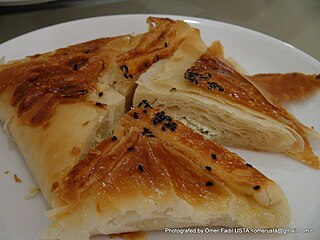Related Research Articles

Bagpipes are a woodwind instrument using enclosed reeds fed from a constant reservoir of air in the form of a bag. The Great Highland bagpipes are well known, but people have played bagpipes for centuries throughout large parts of Europe, Northern Africa, Western Asia, around the Persian Gulf and northern parts of South Asia.

The Hemshin people, also known as Hemshinli or Hamshenis or Homshetsi, are a bilingual small group of Armenians who practice Sunni Islam after they had been converted from Christianity in the beginning of the 18th century and are affiliated with the Hemşin and Çamlıhemşin districts in the province of Rize, Turkey. They are Armenian in origin, and were originally Christian members of the Armenian Apostolic Church, but over the centuries evolved into a distinct community and converted to Sunni Islam after the conquest of the region by the Ottomans during the second half of the 15th century. In Turkey, apart from those living in provinces of Artvin and Sakarya, Hemshin people do not speak the Homshetsi dialect and their mother tongue is Turkish.

The Pontic Greeks, also Pontian Greeks or simply Pontians, are an ethnically Greek group indigenous to the region of Pontus, in northeastern Anatolia. They share a common Pontic Greek culture that is distinguished by its music, dances, cuisine, and clothing. Folk dances, such as the Serra, and traditional musical instruments, like the Pontic lyra, remain important to Pontian diaspora communities. Pontians traditionally speak Pontic Greek, a modern Greek variety, that has developed remotely in the region of Pontus. Commonly known as Pontiaka, it is traditionally called Romeika by its native speakers.

Giresun, formerly Cerasus, is a city in the Black Sea Region of northeastern Turkey, about 175 km (109 mi) west of the city of Trabzon. It is the seat of Giresun Province and Giresun District. It has a population of 125,682 (2022).
Ahmet Yalçınkaya is a Turkish poet and academic.

Dankiyo, is an ancient word from the text of Evliya Çelebi (17th century, Ottoman Era "The Laz's of Trebizond invented a bagpipe called a dankiyo..." describing the Pontian tulum, a type of bagpipe which the ancient Greeks called an askaulos. It consists of a lamb skin, a blow pipe, and the double reed chanter.
Greek traditional music includes a variety of Greek styles played by ethnic Greeks in Greece, Cyprus, Australia, the United States and other parts of Europe. Apart from the common music found generally in Greece, each region of Greece contains a distinct type of folk music that originated from the region due to their history, traditions and cultural influences.

Turkish folk dances are the folk dances of Turkey. Facing three seas, straddling important trade routes, Turkey has a complex, sophisticated culture, reflected in the variety of its dances. The dominant dance forms are types of line dance. There are many different types of folk dances performed in various ways in Turkey. Zeybek, Teke Zortlatması in Aegean region, Bar in Erzurum province, Halay in the central, southern, eastern, and southeastern parts of the country, Hora in Thrace, Horon in the eastern Black Sea region, Spoon dances in and around Konya, and Lezginka in Kars and Ardahan are some of the best known examples of these.

The tulum is a musical instrument, a form of bagpipe from the Black Sea region of Turkey. It is droneless with two parallel chanters, and is usually played by the Laz, Black sea Turks, Hemshin peoples and by Pontic Greeks, particularly Chaldians. It is a prominent instrument in the music of Pazar, Hemşin, Çamlıhemşin, Ardeşen, Fındıklı, Arhavi, Hopa, some other districts of Artvin and in the villages of the Tatos range of İspir. It is the characteristic instrument of the transhumant population of the northeastern provinces of Anatolia and, like the kemençe in its area, the tulum imposes its style on all the dance and entertainment music of those for whom it is "our music".
Tulum is an archaeological site of the Maya civilization in Mexico. It may also refer to:

Horon is a group of traditional folk dances from the Eastern Black Sea Region in Turkey.
The zukra is a Libyan bagpipe with a double-chanter terminating in two cow horns; it is similar in construction to the Tunisian mizwad.

Chepni is one of the 24 Oghuz Turkic tribes.
Sheep's sorrel soup is a soup made from sheep's sorrel leaves, water, corn, beans, onions, butter and salt. Sheep's sorrel soup is a dish from the Black Sea city of Giresun popular among Turkish people. It may have a tart and lemony flavor. It may be served garnished with chives or bull thistle, among other ingredients.
Beylik of Hacıemir was a beylik (lordship) in the north Anatolia in a part of 14th and 15th centuries. The historical documents about the beylik are scarce. In some documents the beylik was named Bayramoğulları and in others Hacıemiroğulları. Hacıemir was Bayram's son. In contemporary Greek documents, the name of the beylik was Chalybia, after the ancient Chalybes people who lived in the area.

The Ümraniye massacre or Ümraniye incident was a massacre of five workers in Ümraniye, Istanbul, Turkey committed by Communist Party of Turkey/Marxist–Leninist members on 17 March 1978. Two of the five victims had their eyes gouged, some of them had their ears cut off and some of them had their penises cut off. They were all shot in their heads. The political position of the victims is unknown, statements from officials claim they were apolitical while right-wing sources claim they were idealists.

Kete is a Turkish flaky pastry.

The bülban is a historical musical instrument from the Caucasus, Middle East and Central Asia. It was a reed pipe, with an apricot wood body and tipped with a tubular single-reed. It had 7 fingerholes and a thumbhole and played a diatonic scale from E♭1 to E♭3. By half-covering fingerholes, it could play a chromatic scale. The instrument has been documented in Azerbaijan, and one can be seen in a photo from the mid-19th-century Russian Turkestan.
References
- ↑ Broughton, Simon; Ellingham, Mark; Trillo, Richard (2000). World Music Volumn 2 Latin and North America Caribbean India Asia and: Pacific the Rough Guide. Rough Guides. pp. 26–. ISBN 978-1-85828-636-5 . Retrieved 19 May 2013.
- ↑ Stepan Bulgar (2004). Veysel Arseven (Vasili Öküzçü) 1919-1977. Türksoy. ISBN 978-975-7213-19-2 . Retrieved 19 May 2013.
- ↑ Gazanfer İltar (2009). Uluslararası Giresun ve Doğu Karadeniz Sosyal Bilimler Sempozyumu: 09 - 11 Ekim 2008 : bildiriler. Giresun Belediyesi. ISBN 978-975-94723-6-8 . Retrieved 19 May 2013.
- ↑ Mahmut R. Gazimihal; Nail Tan; Ahmet Çakır (1997). Türk halk oyunları kataloğu. Kültür Bakanlığı. Retrieved 19 May 2013. - Artvin'in esas çalgısı olan "tulum zurna" eşliğiyle icra edilirler. Tulum zurnanın her oyuna ait olarak bîteviye (aralıksız, sürekli)